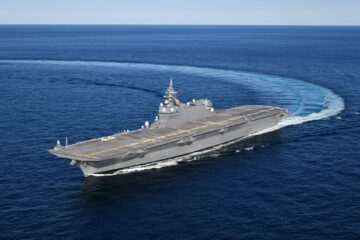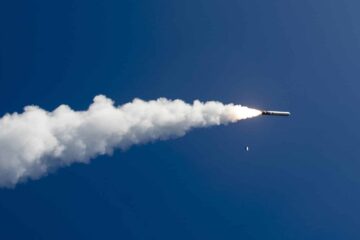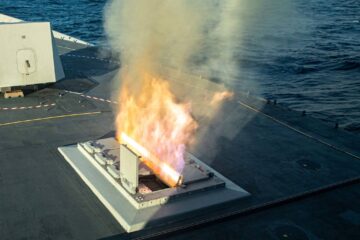USMC Story by Lance Cpl. Tyler Harmon
Following a series of modifications to the JS Izumo to enable short take-off and vertical landing (STOVL) operations, a capability that the “B” variant of the F-35 specializes in, U.S. Marines embarked aboard the JS Izumo and worked directly with JMSDF personnel as part of a bilateral effort to ensure the capability test was both effective and safe.
“This trial has proved that the JS Izumo has the capability to support takeoffs and landings of STOVL aircraft at sea, which will allow us to provide an additional option for air defense in the Pacific Ocean in the near future”, said JMSDF Rear Admiral Shukaku Komuta, commander of Escort Flotilla One.
Japan is one of 14 nations worldwide that participate in the F-35 Lightning II Joint Strike Fighter program and announced in August, 2019 that they would purchase 42 F-35B aircraft from the United States. This announcement was particularly significant since the last time Japan operated an aircraft carrier was over 75 years ago.
“We still have work to do until the day the JSDF can regularly employ STOVL aircraft at sea, but I am confident that the strong partnership and mutual trust between our two counties will result in its realization,” said Komuta.
The F-35 includes the latest stealth technology and has an advanced suite of sensors that enables it to create a dynamic awareness of the battlespace. The F-35 is then able to rapidly share this information with other aircraft platforms and command centers, including those operated by multinational allies and partners, creating greater situational awareness for commanders.
“We have the utmost confidence in the Joint Strike Fighter and are eager for our Japanese allies to have the same capabilities in their hands, which ultimately contributes to our shared goal of maintaining a free and open Indo-Pacific,” said Major General Brian W. Cavanaugh, 1st Marine Aircraft Wing Commanding General.
VMFA-242 is one of two F-35B squadrons permanently stationed at Marine Corps Air Station Iwakuni, Japan and is one of the many forward-stationed units that routinely train with Japan Self-Defense Forces. The F-35B represents the United States’ rebalance to the Indo-Pacific and our commitment to the defense of Japan and regional security with the most capable and modern equipment in the U.S. inventory.
The U.S.-Japan Alliance serves as the cornerstone for regional peace and security for over 60 years and remains indispensable to our mutual security interests in the Indo-Pacific. Our alliance is built on shared interests, shared values, a commitment to freedom and human rights, and maintaining a free and open Indo-Pacific. The Alliance has never been stronger, and it’s never been more important to this region than right now as we face difficult security challenges. The United States is committed to the defense of Japan, and combined training and testing such as this allows us to improve interoperability and remain a credible deterrence to the increasingly severe threats in the region.





